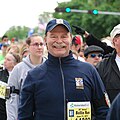
The Green Bay Packers are a professional American football team based in Green Bay, Wisconsin. [1] The Packers were founded in 1919 by Curly Lambeau and George Whitney Calhoun; for the first two years the team competed against local teams based in cities around the Wisconsin and Michigan area. In 1921, the Packers were admitted into the National Football League (NFL), which had been formed just one year prior. [2] After experiencing financial difficulties, the Green Bay Football Corporation was formed in 1923 after a public offering of stock raised $5,000. The corporation made the Packers a publicly owned, non-profit organization that was run by a board of directors elected each year. [3] It was later reorganized into its current form, known as Green Bay Packers, Inc., in 1935 after it was in receivership for two years. [4]
Contents
The executive committee, which is elected from the board members, includes three members at-large, a secretary, treasurer, vice president, and president. [5] This ownership structure runs counter to NFL rules, which mandate that no more than 25 people can own a team and at least one person must have an ownership share of 30% or more. However, when this rule was adopted in 1980, the Packers' ownership structure was grandfathered and allowed to remain. [6] As such, the president typically acts in a manner similar to a team owner. They represent the organization on NFL committees, make executive decisions (within the confines of the executive committee and board of directors), hire staff and generally appear as the face of the team in public matters. [7] In 1988, president Robert J. Parins was given the additional title of chief executive officer (CEO), which future presidents have retained. [8] [9] [10] The Packers have a mandatory retirement age for all board members, including president, whenever that person turns 70 years old. Officially, they may retain their seat on the board but are noted as emeritus members and cannot serve in executive positions. [11]
Since conversion to a publicly owned corporation in 1923, there have been eleven presidents of the Packers. [12] Eight of the eleven presidents had been civic leaders in the Green Bay area prior to their tenure; the eight include a former mayor of Green Bay, [13] a circuit court judge, [8] and a medical doctor. [14] The Packers' first president, Andrew B. Turnbull, owned the Green Bay Press-Gazette and was instrumental in the formation of the Green Bay Football Corporation in 1923. [15] Three presidents only served for one season: Ray Evrard in 1928, W. Webber Kelly in 1929 and John Jones in 2006, although all three served in other roles for the Packers prior to and after their presidency. [12] [16] [17] [18] Dominic Olejniczak, a former mayor of Green Bay, is the longest serving president, with his tenure lasting 23 years from 1958 to 1981. [13] Only once in the history of the organization has the presidency been vacant for a full season. [12] After Jones left the team in 2007, the position was not filled until Mark Murphy was elected and took over in January 2008. [10] Bob Harlan, who was the Packers president before Jones and still the CEO, maintained executive control of the organization during the vacancy. [19] [20] As of 2023, Murphy, a former NFL player for the Washington Redskins and college athletic director, is the president of the Packers. [5] [10] In July 2022, he announced that he would retire as president on July 13, 2025, when he turns 70 years old. [21] After an extensive search process, the Packers' board of directors unanimously chose Ed Policy, who served as the team's chief operating officer and general counsel, to be the next president after Murphy's resignation. [22] Policy's position as president and CEO was confirmed at the Packers' shareholder meeting in July 2025. [23]









